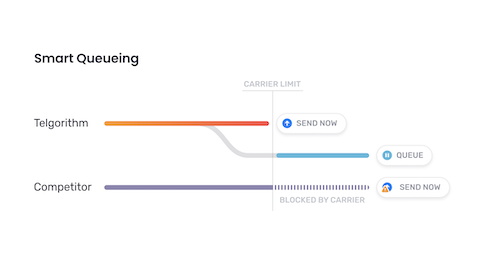Next Gen A2P Messaging API Provides Ultimate Customer Experience for Software Platforms
For many B2B software companies, SMS & MMS text messaging is vital to their product. Whether your a vertical SaaS product needing the fastest customer support, an SMS Marketing platform needing the best deliverability for ROI, or a CRM needing never-fail appointment reminders (the list goes on), your software needs to be powered by the best messaging API to enable your customers to communicate with their B2C customers in the most reliable way possible.
Not to mention less support tickets needed for your team to solve and better trust of your product in the marketplace. A good customer experience (CX) is a good reputation and better retention.
But how do you determine if your software or product is powered by the best messaging API, setting you up to give your customers the best CX?
Before diving into the product features you should look for in a messaging API, you need to know that all business text messaging must be registered/verified.
Whether you’re leveraging 10-digit long code (10DLC), also known as local numbers, or Toll-Free numbers, new regulations are being enforced in an effort to limit spam in the business texting ecosystem.
Application-to-Person (A2P) SMS & MMS Compliance
As a B2B service, before your software or product can send text messaging on behalf of your customers, their A2P SMS & MMS traffic needs to be registered or verified. We spoke recently to Aaron Alter, a long-time industry expert and current CEO and founder of messaging API provider, Telgorithm.
Speaking exclusively to Tech HQ, he said of the A2P regulations: “95 percent of the rules to become verified or registered have been around for a while. The thing is, they’re just now being enforced. Before, it was just a wild west. The new ecosystem will give businesses a legitimate way to be able to message consumers with high throughput [and] high deliverability rates.”
Since these regulations are now just being enforced, they may seem nuanced or challenging for businesses to comply. It’s important to find an SMS & MMS messaging API provider who will guide you through registering your 10DLC numbers with The Campaign Registry (TCR) and/or verifying your Toll-Free numbers.
For example, Telgorithm is partnered with TCR for an API-based Automated Registration, creating a seamless setup to save your team time from manually inputting data and risking human errors. Telgorithm provides expert guidance throughout the process to avoid Campaign vetting rejections and achieve approvals fast and get you on the road to full-compliance.
Once you are fully compliant – you can start to focus on the main areas to look out for in an messaging API provider:
#1 Evaluating an SMS API Provider’s Message Deliverability
When you’re sending critical text messages that businesses rely on to operate, communicate with customers and so on, we can all agree, getting the messages delivered is likely the most important piece of the puzzle.
But if an SMS messaging API provider lists delivery error codes on their website, oftentimes being nondescript, they likely don’t have a system in place to prevent the error in the first place.
Specifically, business text messaging relies heavily on high throughput or rate limits to send large volumes of text messages out to consumers daily. Each Mobile Carrier in North America has different rules for throughput or rate limits, a.k.a the number of messages you can send within a specific period, set in place to limit unsolicited messages and/or SPAM.
It’s important to note that every Carrier’s rate limit is different.
- Verizon monitors rate limits by messages sent per minute per number
- AT&T monitors rate limits by messages sent per minute per Campaign
- T-Mobile monitors rate limits by messages sent per day
For example, if your rate limit is 10,000 texts per day on T-Mobile and one of your customers has a massive influx of traffic and sends more than the allotted 10,000 for the day – any messages sent after exceeding the 10,000 rate limit to T-Mobile users will be dropped/undelivered. Most messaging API providers would then charge you for those dropped messages and send an error code that they were undelivered due to exceeding your rate limit.
Alter said, “it’s common for messaging providers to charge for blocked or dropped messages and even add Carrier fees. This is an example of what goes on in this industry and what Telgorithm is trying to change.”
Next gen SMS Messaging API Technology for 99% Deliverability
That’s why Telgorithm built the solution for high volume business text messages to avoid the drop, giving customers the best deliverability experience.
With its next gen tech, Telgorithm is able to offer 99% deliverability, the highest in the A2P services industry, because it is the only SMS messaging API provider with automated rate limit management technology (which it calls Smart Queueing) that prevents you from being capped or from ever exceeding your SMS/MMS rate or send limits set by Carriers like Verizon, AT&T, T-Mobile etc.
Made possible by automated technology that auto-tracks and auto-manages TCR and Carrier rate limits for a customer alongside how many messages have been sent each second, minute and day to each Carrier. Once you reach your rate limit, Telgorithm automatically queues the messages that would have dropped with any other provider, to save senders from hitting their rate limits and holds them to be sent until the rate limit refreshes, keeping delivery metrics high.
This means a business will never exceed the TCR or Carrier rate limits i.e. never experience a blocked or dropped text, keeping customers happy and keeping the bottom line happy by never losing a penny to undelivered texts.

Source: Telgorithm
Ahead of ever being queued, Telgorithm sends alerts to let you know if you’re nearing any limits so you can proactively apply for added vetting and avoid queueing altogether.
For messages that do get queued, Telgorithm offers unique product features that enable the sender to have full control over their fate. With Telgorithm’s Message Prioritization feature, you can proactively program your most urgent Campaigns to deliver first, giving you peace of mind that they will never be delayed due to queueing.
Additionally, with Telgorithm’s Time Routing feature, you can rescind or “expire” the messages from the queue that no longer need to be sent, like a sale or update that is no longer relevant, for example. Or you can schedule them to be sent during a specific time period, because no one wants a business text message at 1 a.m. This enables businesses to use their rate limits efficiently, save on costs and provide a better overall customer experience.
The biggest takeaway is, if a business is not monitoring which Carrier each of the messages are going to and how many are being sent to each – they likely have poor deliverability, which means their customers have poor user experience when texts get dropped or blocked. Look for a messaging API provider who will take care of this for you and your customers.
#2 Evaluating an SMS API Provider’s Customer Support
This may seem like an obvious one – but it’s not as obvious to catch the warning signs of a bad customer support team upfront.
It’s typical in the B2B industry to be heavily sold and courted in the beginning, only to be deprioritized three months into a partnership now that you’ve been integrated.
Look for partners who provide transparent and helpful support from the beginning and never gatekeep expert insights so a sure sign that they will be reliable throughout the partnership. A fast CX for your B2B customers means an even faster reply to their B2C customers.
Telgorithm is known for the best customer support in the industry and is best described as a customer-first provider. “There is no better, happier classification that my company can get than one that’s a CX company. We believe the key to success at any business is a great customer experience. That’s why we give our customers the very best service, so they can in turn give their customers the best experience.” Mr Alter said.
Where Telgorithm stands out is in its proactive approach so businesses always have fast, real-time access to its support and technical staff via a dedicated Slack channel. As a provider that is deeply knowledgeable in A2P messaging, Telgorithm aims to always provide industry guidance in order to keep customers informed and ahead of the curve.
This is something that will always be included in Telgorithm’s service, 100% free.
Migration made easy
If upgrading your messaging API to improve your customers’ experience with your product is on the roadmap, moving to Telgorithm is extremely easy despite the industry’s reputation for this process being time consuming. In fact, “the average time is about a week, maximum, to integrate. You can use literally just two lines of code added to your systems to begin. We built APIs to make it so easy to transition from any of our competitors,” said Alter.
Telgorithm offers excellent API documentation to get started as well as Automated Number Porting so your team can port active and existing phone numbers from another API provider to Telgorithm instantly and in bulk to avoid customer disruptions. Light work for your engineering team. Auto-Number Porting also makes it easier to get new customers onboarded faster for a great introductory CX.
Contact a Telgorithm team member to learn more about how they are changing the A2P SMS industry in North America.









